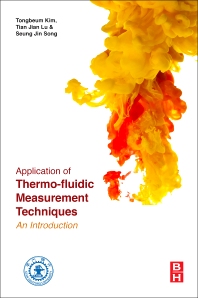LIMITED OFFER
Save 50% on book bundles
Immediately download your ebook while waiting for your print delivery. No promo code is needed.
Application of Thermo-Fluidic Measurement Techniques: An Introduction provides essential measurement techniques in heat transfer and aerodynamics. In addition to a brief, but physi… Read more

LIMITED OFFER
Immediately download your ebook while waiting for your print delivery. No promo code is needed.
Application of Thermo-Fluidic Measurement Techniques: An Introduction provides essential measurement techniques in heat transfer and aerodynamics. In addition to a brief, but physically elaborate description of the principles of each technique, multiple examples for each technique are included. These examples elaborate all the necessary details of (a) test setups, (b) calibration, (c) data acquisition procedure, and (d) data interpretation, with comments on the limitations of each technique and how to avoid mistakes that are based on the authors’ experience.
The authors have different expertise in convection heat transfer and aerodynamics, and have collaborated on various research projects that employ a variety of experimental techniques. Each author has a different view and approach to individual experimental techniques, but these views complement each other, giving new users of each technique a rounded view.
With the introduction of this valuable reference book, the reader can quickly learn both the overall and detailed aspects of each experimental technique and then apply them to their own work.
1. Experimentation in Aerodynamics and Heat Transfer1.1. Introduction1.2. Aerodynamics1.3. Convection and conduction heat transfer1.4. Classification of measurement techniques1.5. ClosureReferences
MEASUREMENTS IN AERODYNAMICS
2. Flow Visualization2.1. Introduction2.2. Surface flow visualisation using oil-dye technique2.3. Surface flow visualization using thermochromic liquid crystal2.4. Surface flow visualization using infrared thermography2.5. In-flow visualisation using neutrally buoyant helium bubbles2.6. In-flow visualisation using planar laser imaging2.7. In-flow visualisation using ink-dye pigment injectionReferences
3. Pneumatic Measurements for Pressure, Velocity, Flow-rate and Flow-direction3.1. Introduction3.2. Static pressure measurement3.3. Stagnation (total) pressure measurement3.4. Velocity measurement3.5. Mass/volume flow rate measurement3.6. Flow direction measurementReferences
4. Fast Response Pressure, Velocity and Shear Stress Measurements4.1. Introduction4.2. Piezo-resistive sensor (pressure)4.3. Hot-wire anemometry (velocity and turbulence)4.4. Hot-film sensor (shear stress)ExamplesReferences
5. Velocity Field Measurements Using Particle Image Velocimetry5.1. Introduction5.2. How PIV works5.3. PIV system parametersReferences
MEASUREMENTS IN HEAT TRANSFER
6. Point Temperature Measurements6.1. Introduction6.2. Thermocouple6.3. Surface mountable thermocouple6.4. Resistance temperature detector (RTD)6.5. Heat flux sensorReferences
7. Surface Heat Transfer Mapping Using Thermochromic Liquid Crystal7.1. Introduction7.2. Properties of thermochromic liquid crystal7.3. Application and calibration7.4. Post image analysis for heat transfer coefficientReferences
8. Surface Temperature Mapping Using Infrared Thermography8.1. Introduction8.2. Principles8.3. Calibration8.4. Post image analysis for heat transfer coefficient and heat fluxReferences
TK
TL
SS
His current research interests include aerodynamics and fluid-structure interactions in turbomachinery, analysis of propulsion/power generation systems, and related areas of fluid mechanics.
He received the Best Paper Award from the Turbomachinery Committee of the International Gas Turbine Institute (IGTI) of the American Society of Mechanical Engineers (ASME) and the Best Paper Award from the Structures and Dynamics Committee of the IGTI in 2000. In 2003, he received the Melville Medal, the highest academic honor bestowed by ASME. He has also been recognized for his teaching by receiving the Best Teacher Award from the College of Engineering at Seoul National University in 2002, 2006 and 2007.
He is an active member of the Korean Society for Fluid Machinery (KSFM). Currently, he is the Chair of ASME IGTI Board of Directors.